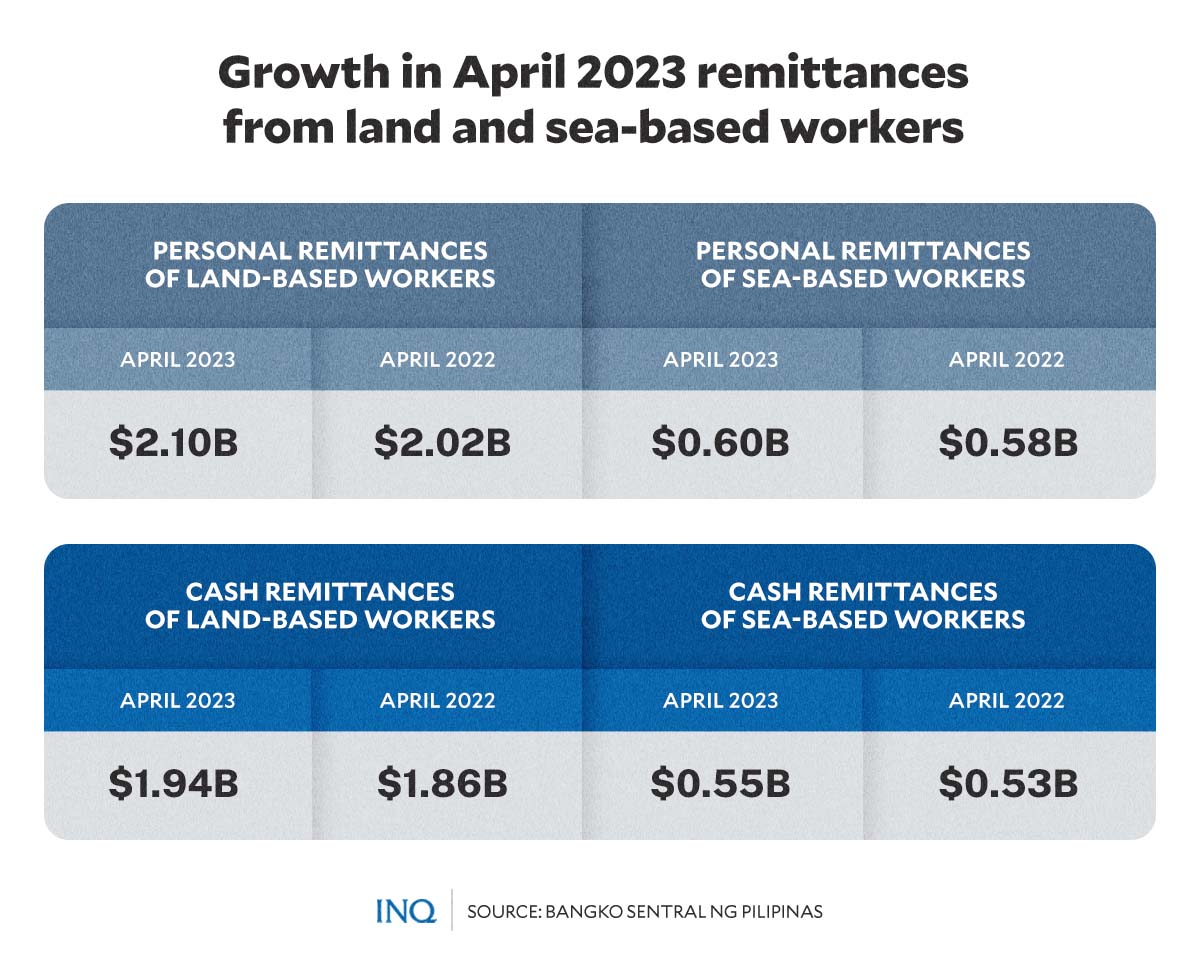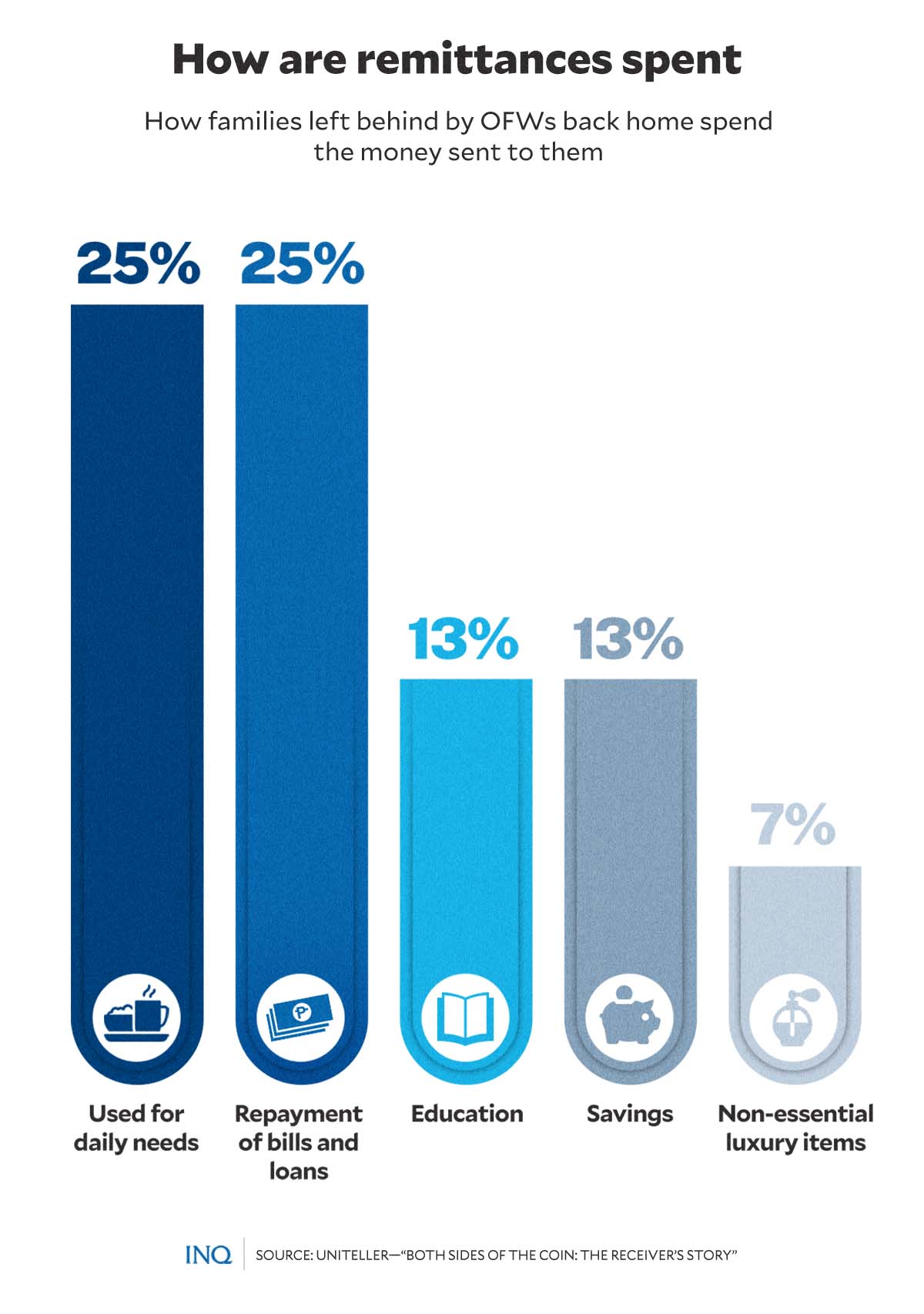Post-COVID remittances fling PH back on list of biggest migrant worker money recipients
MANILA, Philippines—Following the slowdown and restrain in the inflow of remittances early in the COVID-19 pandemic, the amount of money sent home by overseas Filipino workers (OFWs) continued to rise—making the country among the world’s top remittance recipients.
Due to factors like temporary or permanent loss of jobs among migrants and underemployment in host countries whose economies have contracted or experienced significant growth slowdown during the COVID-19 pandemic, the World Bank previously projected that global remittances would decline by 7 percent in 2020.
In the Philippines, where remittances from OFW remain an integral part of the country’s economy, it was projected by a multinational banking and financial services corporation that remittances would fall by up to 6.9 percent in 2020.
Data from the Philippine Statistics Authority (PSA) showed that from April to September of that year, total remittances sent by OFWs totaled P134.77 billion, or an average of P86,081 sent by every OFWs—lower than the average remittance valued at P106,062 sent in 2019 for the same months.
However, remittances sent to the Philippines began to climb in the following years as countries hosting OFWs started to open up and recover economically. These developments thrust the Philippines back into the ranks of low- and middle-income countries with the most remittances received in 2022.
Article continues after this advertisementAmong 2022 top remittance recipients
Data from a report published earlier this month by World Bank and Global Knowledge Partnership on Migration and Development (KNOMAD) showed that remittance flows to low- and middle-income countries rose by 8 percent in the post-COVID period, reaching US$647 billion.
Article continues after this advertisement“This increase is remarkable, given that it followed a 10.6 percent growth rate in 2021, and the economic environment seemed difficult due to slowing economies around the world, inflation, and the war in Ukraine,” the report said.
Analysis by World Bank and KNOMAD showed that the Philippines ranked fourth on the list of top countries for remittances in 2022, with total remittances amounting to US$38 billion that year.
The report noted that the country’s remittances grew by about 4 percent from US$36.7 billion in 2021, “benefiting from a lifting of the ban on emigration to Saudi Arabia due to the abusive treatment of workers, and specific deals forged by the Filipino government, especially in new OECD [Organization for Economic Co-operation and Development] destinations.“
READ: Dep’t of Migrant Workers lifts deployment ban of Filipino workers in Saudi
The Philippines was also the largest recipient after China in the East Asia and Pacific region.
Among developing nations, India and Mexico received the most remittances last year—amounting to US$111.2 billion and US$61.1 billion, respectively. Both countries also saw huge increases in remittance payments compared to 2021, at 19.6 percent and 11.5 percent.
China meanwhile had US$51.0 billion in remittances, making it the third top remittance recipient in 2022. However—unlike India, Mexico, and the Philippines—China saw a 3.9 percent drop compared to its 2021 total remittances.
“Remittances to China have declined in recent years as an aging population and rising prosperity slowed the pace of less-skilled emigration,” the World Bank and KNOMAD explained.
Completing the list of top five recipient countries for remittances in 2022 was Pakistan, with total remittances amounting to US$30 billion—despite a 4.3 percent decline compared to its 2021 remittances.
2023 remittances show resilience
This year opened strong in terms of remittances as data from the Bangko Sentral ng Pilipinas (BSP) showed that money sent home by OFWs through banks was up by 3.5 percent to US$2.76 billion in January from US$2.67 billion in the same month last year.
According to the BSP, “growth in cash remittances from the United States (US), Saudi Arabia, Japan, and Singapore contributed largely to the increase in remittances in January 2023.”
The BSP also attributed the increase in cash remittances in January to the growth in receipts from land- and sea-based workers—which amounted to US$2.19 billion and US$580 million, respectively.
Meanwhile, personal remittances, including the sum of net compensation of OFWs and personal transfers, totaled US$3.07 billion in January—about 3.5 percent higher than it was in the same period last year, which amounted to US$2.97 billion.
“The increase in personal remittances in January 2023 was due to higher remittances sent by 1) land-based workers with work contracts of one year or more and 2) sea- and land-based workers with work contracts of less than one year,” the BSP explained.
Growth seen in April remittance
The year-on-year growth rates of the amount of money sent by OFWs further climbed in April, as personal remittances increased by 3.8 percent reaching US$2.77 billion from US$2.67 billion in the same month last year.
This was the same growth rate observed in April 2022, but faster than the 3 percent recorded in March.
READ: OFW remittances up 3.8% in April
Cash remittances coursed through banks also saw an increase as it rose by 3.7 percent from US$2.40 billion in April last year to US$2.48 billion in the same period this year.
Data from BSP showed that personal remittances in April raised the annual tally to US$11.68 billion, around 2.3 percent more than the US$11.32 billion in 2022. Cash remittances likewise climbed by 3.2 percent from US$10.17 billion in the first four months of 2022 to US$10.49 billion during the same period this year.
Higher remittances from land- and sea-based workers contributed to the increase in personal remittances and the expansion of cash remittances in April.
‘Resilient, but slowing’
While remittances have proven to be resilient during the post-COVID period, the World Bank and KNOMAD stressed that growth of remittances might moderate to 1.4 percent in 2023 to a level of US$656 billion due to slowing economic growth in major source countries.
“Slower growth in remittances is expected in all regions, notably in Europe and Central Asia (1 percent) and South Asia (0.3 percent),” said the World Bank and KNOMAD.
“In Europe and Central Asia, the growth in remittances is slowing down because of a high base effect, lingering weakness inflows to Ukraine and Russia, and the weakening of the ruble against the US dollar.”
It is also expected that worldwide layoffs in the information technology sector, lower oil prices, and the continued diversion of remittance flows to informal channels will contract growth in remittances in South Asia.
“Some of the weakness in remittances in the Philippines and Thailand is related to a slowdown in emigration triggered by the revival of tourism, which creates more job opportunities for workers at home, thus demotivating a search for jobs in foreign countries,” the report said.
However, the same report noted that remittance inflows to the Philippines, “which accounts for about 48 percent of the total remittances to East Asia and the Pacific Islands, excluding China,” are projected to grow by around 2.5 percent to reach US$39 billion in 2023 and US$40 billion in 2024.
Where OFW remittances go
As OFWs continue to send money to the Philippines to help the families they left behind to cope with higher inflation locally, a 2019 study by US-based international payments company UniTeller showed that recipients still run out of money due to poor financial planning.
According to the study, half of the remittances sent by OFWs to their families are used for the family’s day-to-day needs (25 percent) and to pay bills and loans (25 percent).
Meanwhile, “much smaller sums” are allocated to other necessities such as education (13 percent) and savings (13 percent). Recipients likewise use up to 7 percent of the remittances they get for non-essential luxury items.
Most of the time—around 82 percent—the recipients of the remittances have the final say on how the cash sent by OFWs will be spent or used. Unfortunately, 19 percent of the recipient families admitted that they regularly run out of money due to poor financial planning.
“As the reliance on remittances grows, a key challenge is ensuring this income translates to building sustainable wealth,” said UniTeller Philippines president Noel Cristal.
Pattern of spending
When recipients of remittances from OFWs run out of cash, 72 percent said they usually reach out to the sender. Meanwhile, 53 percent said they would forgo spending on everyday needs when there is nothing left from the money sent to them.
This pattern of spending, including the expectation of receiving remittance causes emotional stress on the family back in the Philippines. Around 54 percent said that this issue also affects the relationship between the recipients and the sender or the OFWs.
Still, while the study stressed that receivers do not set aside enough of the remittances for savings, it revealed that 75 percent of those who regularly receive remittances in the Philippines are extremely eager to learn good financial habits.






